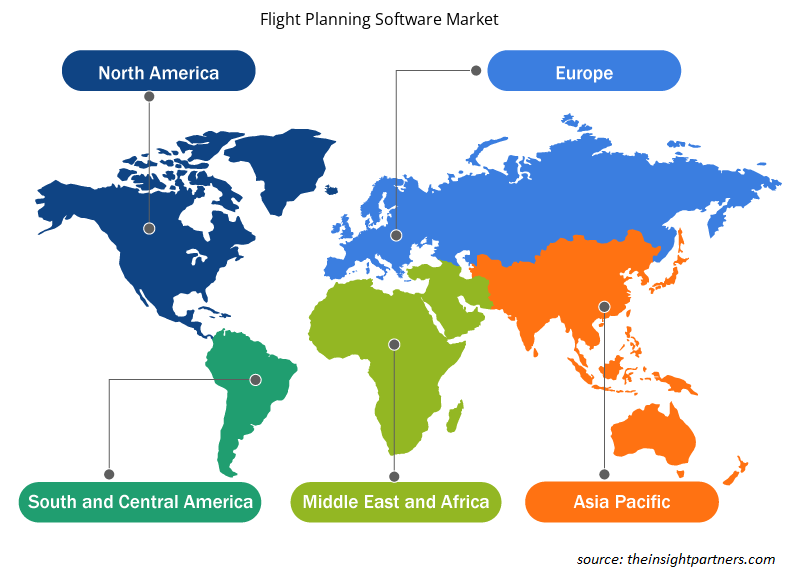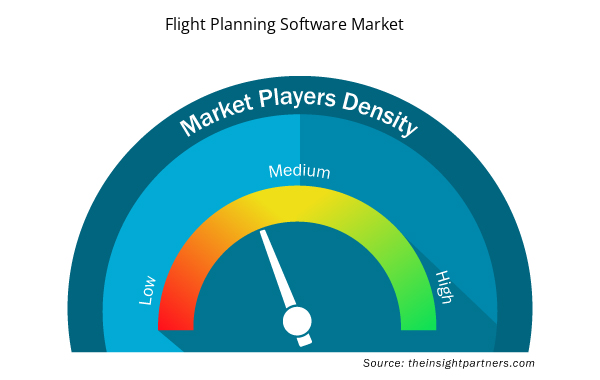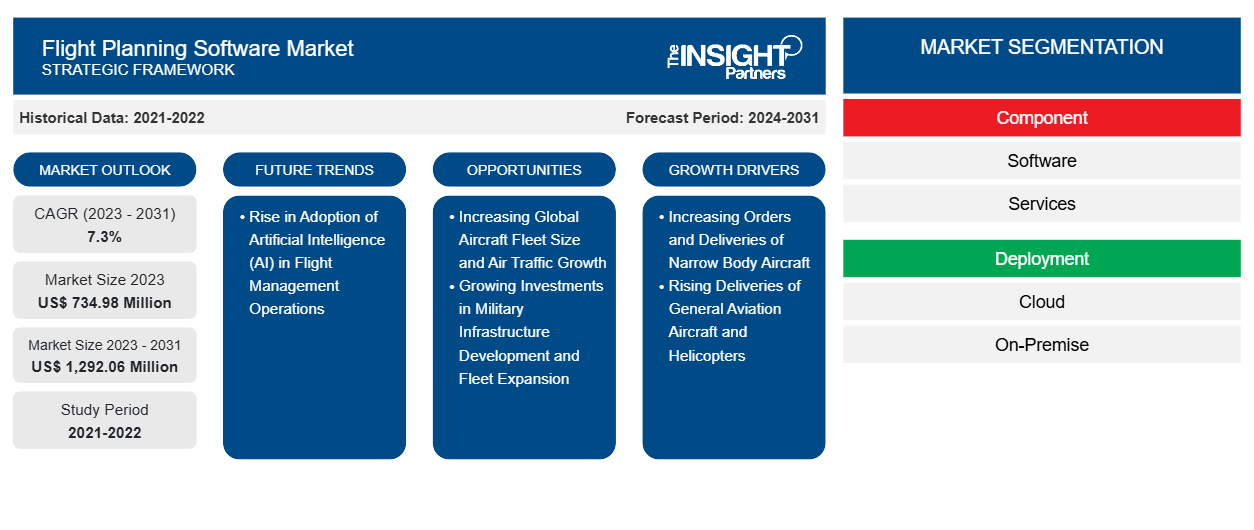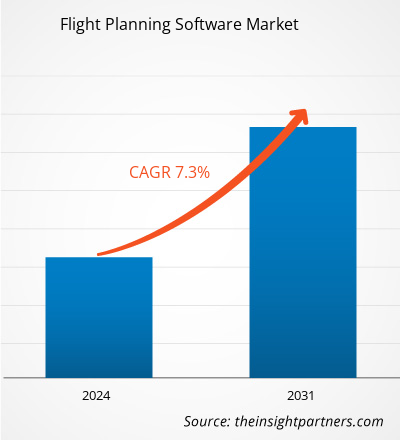飛行計画ソフトウェアの市場規模は、2023年の7億3,498万米ドルから2031年には12億9,206万米ドルに達すると予測されています。市場は2023年から2031年の間に7.3%のCAGRを記録すると予想されています。飛行管理業務における人工知能(AI)の採用の増加は、市場のトレンドになる可能性があります。
フライトプランニングソフトウェア市場分析
飛行計画ソフトウェア市場の成長を牽引する主な要因には、ナローボディ機、一般航空機、ヘリコプターの受注と納入の増加が含まれます。ただし、飛行管理データに関連する課題が、飛行計画ソフトウェア市場の成長を妨げています。さらに、世界的な航空機フリートサイズと航空交通量の増加、および軍事インフラ開発とフリート拡張への投資の増加により、予測期間中に飛行計画ソフトウェア市場で活動する主要企業にチャンスが生まれると予測されています。さらに、飛行管理業務における人工知能 (AI) の採用と役割の増加は、2023年から2031年までの飛行計画ソフトウェア市場の主要なトレンドになると予想されます。
フライトプランニングソフトウェア市場の概要
飛行計画ソフトウェアは、ルートの最適化、気象分析、燃料の見積りのためのツールを提供し、現代の航空業界では欠かせないものとなっています。飛行計画ソフトウェアは、時間の経過とともに変化し発展するすべての関連する気象条件をパイロットに最新の状態で提供します。航空機が遭遇する気象を事前に知ることは、パイロットが航空機の位置について慎重な決定を下すのに役立ちます。市場は、商業航空会社、ビジネス航空、軍事作戦、一般航空の分野にサービスを提供しており、基本的な飛行計算機から高度なエンタープライズレベルのシステムまで、さまざまなソリューションを提供しています。ディスパッチの最適な利用、正確な飛行計画、動的な空中再計画、動的なルート最適化は、飛行操作の全体的なパフォーマンスに影響を与える変数の一部です。飛行計画アルゴリズムは、最新の気象予報を使用して、乱気流に遭遇する可能性が低い飛行ルートを決定できます。航空交通管理ソリューションは、飛行計画の問題によって発生するコストを削減するために、ルート最適化と統合されています。
飛行計画ソフトウェアは、ルート計画と最適化、乗務員のスケジュールと管理、気象の追跡と分析、航空機のパフォーマンス監視、飛行追跡、飛行計画、燃料使用の最適化に使用されます。航空業界は、ハイパーループなどの未来的な代替輸送手段や、高度な AR/VR テクノロジの重要性により、よりダイナミックになっています。長距離旅行では依然として飛行機での移動が好まれていますが、業界が人工知能 (AI)、ビッグデータ、機械学習、機内接続などの高度なテクノロジに適応するにつれて、シナリオは変化する可能性があります。企業は、航空会社や空港の生産性向上、コスト削減、乗客の体験向上に役立つ飛行計画ソフトウェア ソリューションを開発しています。
要件に合わせてレポートをカスタマイズする
このレポートの一部、国レベルの分析、Excelデータパックなど、あらゆるレポートを無料でカスタマイズできます。また、スタートアップや大学向けのお得なオファーや割引もご利用いただけます。
- このレポートの主要な市場動向を入手してください。この無料サンプルには、市場動向から見積もりや予測に至るまでのデータ分析が含まれます。
フライトプランニングソフトウェア市場の推進要因と機会
ナローボディ機の受注と納入が増加
航空業界は長年にわたって急速に成長し、航空機の生産と納入が相当数に上っています。これにより、世界中のさまざまな民間航空機メーカーに膨大な数の注文が寄せられています。今後数年間、航空旅客数と航空機数の増加に伴い、民間航空は急増すると予想されています。世界中でナローボディの旅客機と民間航空機の注文が増加しているため、飛行計画ソフトウェアの需要が高まっています。そのため、航空会社は、より小さな都市の空港への路線を開始することで、より遠隔地への拡大を計画しています。航空機と空港の数が増えるにつれて、飛行計画ソフトウェアの需要も高まっています。
世界の航空機数の増加と航空交通量の増加
エアバスGMF 2024の世界の航空機群と交通に関する調査によると、航空機群は2023年の24,260機から2043年までに48,230機に増加すると予想されています。これは、COVID-19による渡航制限以降の急速な回復を踏まえ、航空旅行の需要が継続的に増加しているためです。アボロンの調査によると、中国、インド、アジア、南米では2023年から2042年にかけて航空旅行が3.5%以上増加すると予想されていますが、北米とヨーロッパではこの期間中に2~3%の緩やかな成長が見込まれています。さらに、上記の地域の航空機群の数が大幅に増加することで、世界中の主要な飛行計画ソフトウェアメーカーにチャンスが生まれると予想されています。
エアバスGMFによると、2024年から2043年までの新造機の需要は42,430機と見積もられています。調査期間中、アジア太平洋地域は新造機の総需要の45.98%を占めると予想され、次いで欧州・CIS、北米が続きます。単通路機は、2024年から2043年までの世界の新造機総需要の80%以上を占めると予想されています。さらに、貨物機の需要は、2024年から2043年の間に2,470機と見積もられています。
フライトプランニングソフトウェア市場レポートのセグメンテーション分析
飛行計画ソフトウェア市場分析の導出に貢献した主要なセグメントは、コンポーネント、展開、およびアプリケーションです。
- コンポーネントに基づいて、世界の飛行計画ソフトウェア市場はソフトウェアとサービスに分類されます。ソフトウェアセグメントは2023年に大きな市場シェアを占めました。
- 展開別に見ると、市場はクラウドとオンプレミスに分かれています。2023 年にはクラウド セグメントが市場で大きなシェアを占めました。
- アプリケーションに基づいて、市場は物流と貨物、空港、民間航空会社、商業航空会社、飛行学校とトレーニングセンター、軍事と防衛に分かれています。商業航空会社セグメントは2023年に市場で最大のシェアを占めました。
地域別のフライトプランニングソフトウェア市場シェア分析
フライト プランニング ソフトウェア市場レポートの地理的範囲は、主に北米、アジア太平洋、ヨーロッパ、中東およびアフリカ、南米の 5 つの地域に分かれています。
アジア太平洋地域は、2023年に32.1%のシェアで飛行計画ソフトウェア市場を支配しました。予測期間中もその支配を維持し、2031年までに35.1%のシェアを占める可能性があります。北米は、ヨーロッパに続いて飛行計画ソフトウェア市場に2番目に大きな貢献者です。北米は、飛行計画ソフトウェアの進歩と飛行管理業務への導入を支援することに注力している主要企業の存在により、市場で驚異的な成長を遂げています。Airlines for Americaが2023年に発表したデータによると、商業航空は2023年に米国のGDPの5%、つまり1.37兆米ドルを占めました。さらに、航空旅客交通量の増加と、防衛および商業航空部門での航空機隊の増加に向けた政府の取り組みにより、予測期間中に飛行計画ソフトウェアなどの飛行管理ソリューションの需要が高まると予想されます。
アジア太平洋地域では、市場の成長は主に、同地域の航空機群の拡大と空港インフラの発展によるものです。国際航空運送協会は、2036 年までに 21 億人の旅行者が旅行する見込みで、特に中国ではその傾向が顕著です。乗客数の増加により、フライト管理ソフトウェアとサービスの需要が高まることが予想されます。この要因により、予測期間中にフライト プランニング ソフトウェア市場で活動する主要企業にチャンスが生まれると予想されます。
ヨーロッパの飛行計画ソフトウェア市場は、ドイツ、イタリア、ロシア、フランス、英国、その他のヨーロッパに分かれています。1日あたり2万便以上のフライトと年間約5億人の乗客を抱えるヨーロッパは、世界で最も混雑した空域と考えられています。さらに、ヨーロッパの防衛および商業航空部門は、飛行計画ソフトウェアなどの高度な飛行管理技術に傾倒しています。これらの部門は、好調な経済状況とヨーロッパ各国の政府による好ましい取り組みにより拡大しています。
フライトプランニングソフトウェア市場の地域別分析
予測期間を通じてフライト プランニング ソフトウェア市場に影響を与える地域的な傾向と要因は、Insight Partners のアナリストによって徹底的に説明されています。このセクションでは、北米、ヨーロッパ、アジア太平洋、中東およびアフリカ、南米および中米にわたるフライト プランニング ソフトウェア市場のセグメントと地理についても説明します。

- フライトプランニングソフトウェア市場の地域別データを入手
フライトプランニングソフトウェア市場レポートの範囲
| レポート属性 | 詳細 |
|---|---|
| 2023年の市場規模 | 7億3,498万米ドル |
| 2031年までの市場規模 | 12億9,206万米ドル |
| 世界のCAGR(2023年~2031年) | 7.3% |
| 履歴データ | 2021-2022 |
| 予測期間 | 2024-2031 |
| 対象セグメント | コンポーネント別
|
| 対象地域と国 | 北米
|
| 市場リーダーと主要企業プロフィール |
|
フライトプランニングソフトウェア市場のプレーヤー密度:ビジネスダイナミクスへの影響を理解する
フライト プランニング ソフトウェア市場は、消費者の嗜好の変化、技術の進歩、製品の利点に対する認識の高まりなどの要因により、エンド ユーザーの需要が高まり、急速に成長しています。需要が高まるにつれて、企業は提供内容を拡大し、消費者のニーズを満たすために革新し、新たなトレンドを活用し、市場の成長をさらに促進しています。
市場プレーヤー密度とは、特定の市場または業界内で活動している企業または会社の分布を指します。これは、特定の市場スペースに、その市場規模または総市場価値に対してどれだけの競合相手 (市場プレーヤー) が存在するかを示します。
フライトプランニングソフトウェア市場で事業を展開している主要企業は次のとおりです。
- アマデウス IT グループ SA
- コリンズエアロスペース
- CAE株式会社
- NAVフライトサービス
- ジェッペセン
- セイバーGLBL株式会社
免責事項:上記の企業は、特定の順序でランク付けされていません。

- フライトプランニングソフトウェア市場のトップキープレーヤーの概要を入手
フライトプランニングソフトウェア市場のニュースと最近の動向
フライト プランニング ソフトウェア市場は、主要な企業出版物、協会データ、データベースなどの一次調査と二次調査後の定性的および定量的データを収集することによって評価されます。フライト プランニング ソフトウェア市場におけるいくつかの開発を次に示します。
- AIR SUPPORT は、Sunlight Air が飛行業務の最適化のために PPS Flight Planning ソフトウェアを選択したと発表しました。(出典: AIR SUPPORT、プレスリリース、2024 年)
- 革新的な航空ソフトウェアソリューションの大手プロバイダーである eTT Aviation は、Sterling Airways が運航する Aleutian Airways を最新の顧客として発表しました。(出典: eTT Aviation、プレスリリース、2024 年)
- ForeFlight LLC は、Apple Vision Pro 専用に設計された革新的な無料アプリ Voyager をリリースしました。(出典: ForeFlight LLC、プレスリリース、2024 年)
フライトプランニングソフトウェア市場レポートの対象範囲と成果物
「フライトプランニングソフトウェア市場の規模と予測(2021〜2031年)」レポートでは、以下の分野をカバーする市場の詳細な分析を提供しています。
- 飛行計画ソフトウェア市場の規模と予測(対象範囲に含まれるすべての主要市場セグメントについて、世界、地域、国レベルで)
- 飛行計画ソフトウェア市場の動向、および推進要因、制約、主要な機会などの市場動向
- 詳細なポーター分析とSWOT分析
- 主要な市場動向、世界および地域の枠組み、主要プレーヤー、規制、最近の市場動向を網羅したフライトプランニングソフトウェア市場分析
- 市場集中、ヒートマップ分析、主要プレーヤー、フライトプランニングソフトウェア市場の最近の動向を網羅した業界展望と競争分析
- 詳細な企業プロフィール
- 過去2年間の分析、基準年、CAGRによる予測(7年間)
- PEST分析とSWOT分析
- 市場規模価値/数量 - 世界、地域、国
- 業界と競争環境
- Excel データセット



Report Coverage
Revenue forecast, Company Analysis, Industry landscape, Growth factors, and Trends

Segment Covered
This text is related
to segments covered.

Regional Scope
North America, Europe, Asia Pacific, Middle East & Africa, South & Central America

Country Scope
This text is related
to country scope.
よくある質問
The flight planning software marketis expected to reach US$ 1292.06 million by 2031.
The key players holding majority shares in the flight planning software market are Collins Aerospace, The Boeing Co, Honeywell International Inc, Amadeus IT Group, and Sabre.
Increasing orders and deliveries of narrow body aircraft, and rising deliveries of general aviation aircraft and helicopters are the major factors that propel the flight planning software market.
The incremental growth expected to be recorded for the flight planning software market during the forecast period is US$ 557.08 million.
The flight planning software market was estimated to be US$ 734.98 million in 2023 and is expected to grow at a CAGR of 7.3 % during the forecast period 2023 – 2031.
Rise in adoption of artificial intelligence (AI) in flight management operations is anticipated to play a significant role in the flight planning software market in the coming years.
Trends and growth analysis reports related to Technology, Media and Telecommunications : READ MORE..
The List of Companies - Flight Planning Software Market
- Amadeus IT Group SA
- Collins Aerospace
- CAE Inc
- NAV Flight Services
- Jeppesen
- Sabre GLBL Inc
- AIR SUPPORT A/S
- FSS Flight Planning
- Navblue
- Laminaar Aviation Infotech Pvt Ltd.
- Universal Weather and Aviation, Inc.
- Lufthansa Systems
- ForeFlight
- Chetu Inc
- eTT Aviation
- GE Aerospace
- IBS Software
The Insight Partners performs research in 4 major stages: Data Collection & Secondary Research, Primary Research, Data Analysis and Data Triangulation & Final Review.
- Data Collection and Secondary Research:
As a market research and consulting firm operating from a decade, we have published and advised several client across the globe. First step for any study will start with an assessment of currently available data and insights from existing reports. Further, historical and current market information is collected from Investor Presentations, Annual Reports, SEC Filings, etc., and other information related to company’s performance and market positioning are gathered from Paid Databases (Factiva, Hoovers, and Reuters) and various other publications available in public domain.
Several associations trade associates, technical forums, institutes, societies and organization are accessed to gain technical as well as market related insights through their publications such as research papers, blogs and press releases related to the studies are referred to get cues about the market. Further, white papers, journals, magazines, and other news articles published in last 3 years are scrutinized and analyzed to understand the current market trends.
- Primary Research:
The primarily interview analysis comprise of data obtained from industry participants interview and answers to survey questions gathered by in-house primary team.
For primary research, interviews are conducted with industry experts/CEOs/Marketing Managers/VPs/Subject Matter Experts from both demand and supply side to get a 360-degree view of the market. The primary team conducts several interviews based on the complexity of the markets to understand the various market trends and dynamics which makes research more credible and precise.
A typical research interview fulfils the following functions:
- Provides first-hand information on the market size, market trends, growth trends, competitive landscape, and outlook
- Validates and strengthens in-house secondary research findings
- Develops the analysis team’s expertise and market understanding
Primary research involves email interactions and telephone interviews for each market, category, segment, and sub-segment across geographies. The participants who typically take part in such a process include, but are not limited to:
- Industry participants: VPs, business development managers, market intelligence managers and national sales managers
- Outside experts: Valuation experts, research analysts and key opinion leaders specializing in the electronics and semiconductor industry.
Below is the breakup of our primary respondents by company, designation, and region:

Once we receive the confirmation from primary research sources or primary respondents, we finalize the base year market estimation and forecast the data as per the macroeconomic and microeconomic factors assessed during data collection.
- Data Analysis:
Once data is validated through both secondary as well as primary respondents, we finalize the market estimations by hypothesis formulation and factor analysis at regional and country level.
- Macro-Economic Factor Analysis:
We analyse macroeconomic indicators such the gross domestic product (GDP), increase in the demand for goods and services across industries, technological advancement, regional economic growth, governmental policies, the influence of COVID-19, PEST analysis, and other aspects. This analysis aids in setting benchmarks for various nations/regions and approximating market splits. Additionally, the general trend of the aforementioned components aid in determining the market's development possibilities.
- Country Level Data:
Various factors that are especially aligned to the country are taken into account to determine the market size for a certain area and country, including the presence of vendors, such as headquarters and offices, the country's GDP, demand patterns, and industry growth. To comprehend the market dynamics for the nation, a number of growth variables, inhibitors, application areas, and current market trends are researched. The aforementioned elements aid in determining the country's overall market's growth potential.
- Company Profile:
The “Table of Contents” is formulated by listing and analyzing more than 25 - 30 companies operating in the market ecosystem across geographies. However, we profile only 10 companies as a standard practice in our syndicate reports. These 10 companies comprise leading, emerging, and regional players. Nonetheless, our analysis is not restricted to the 10 listed companies, we also analyze other companies present in the market to develop a holistic view and understand the prevailing trends. The “Company Profiles” section in the report covers key facts, business description, products & services, financial information, SWOT analysis, and key developments. The financial information presented is extracted from the annual reports and official documents of the publicly listed companies. Upon collecting the information for the sections of respective companies, we verify them via various primary sources and then compile the data in respective company profiles. The company level information helps us in deriving the base number as well as in forecasting the market size.
- Developing Base Number:
Aggregation of sales statistics (2020-2022) and macro-economic factor, and other secondary and primary research insights are utilized to arrive at base number and related market shares for 2022. The data gaps are identified in this step and relevant market data is analyzed, collected from paid primary interviews or databases. On finalizing the base year market size, forecasts are developed on the basis of macro-economic, industry and market growth factors and company level analysis.
- Data Triangulation and Final Review:
The market findings and base year market size calculations are validated from supply as well as demand side. Demand side validations are based on macro-economic factor analysis and benchmarks for respective regions and countries. In case of supply side validations, revenues of major companies are estimated (in case not available) based on industry benchmark, approximate number of employees, product portfolio, and primary interviews revenues are gathered. Further revenue from target product/service segment is assessed to avoid overshooting of market statistics. In case of heavy deviations between supply and demand side values, all thes steps are repeated to achieve synchronization.
We follow an iterative model, wherein we share our research findings with Subject Matter Experts (SME’s) and Key Opinion Leaders (KOLs) until consensus view of the market is not formulated – this model negates any drastic deviation in the opinions of experts. Only validated and universally acceptable research findings are quoted in our reports.
We have important check points that we use to validate our research findings – which we call – data triangulation, where we validate the information, we generate from secondary sources with primary interviews and then we re-validate with our internal data bases and Subject matter experts. This comprehensive model enables us to deliver high quality, reliable data in shortest possible time.


 このレポートの無料サンプルを入手する
このレポートの無料サンプルを入手する